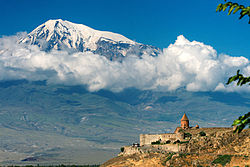
By Daren Butler April 22, 2009
IGDIR, Turkey (Reuters) – Far below Mount Ararat’s snow-covered peak, history weighs heavy on the shoulders of Turks and Armenians seeking to overcome animosity generated by genocide claims and territorial disputes.
A recent diplomatic initiative to restore ties between the arch foes has fueled hopes of economic and strategic benefits. It has also stirred up century-old distrust and fears among locals as they watch developments from the militarized frontier.
The distrust of many in Turkey’s Igdir province is illustrated by a monument near Ararat consisting of five 40-meter-tall swords thrust toward the sky. It commemorates the killing of Turks by Armenians during and after World War One.
The memorial is a riposte to Armenian claims, supported by many countries and academics, that Ottoman Turk forces killed 1.5 million Armenians in a 1915 genocide which is commemorated across the border in Armenia on April 24.
“In Igdir there are still living witnesses who tell their descendants about the killings by Armenians here,” said Goksel Gulbeyi, chairman of an association set up to refute Armenian genocide claims.
Turkey fiercely rejects the genocide charge, saying many were killed on both sides during the conflict.
“There are people here who still feel resentment. The border shouldn’t be reopened until they are reassured,” he said.
At the Alican border gate 15 km (10 miles) away, soldiers send journalists away while farmers dig in surrounding land.
Gulbeyi’s group has launched a campaign to block the reopening of the border, closed by Turkey in 1993 in support of its traditional Muslim ally Azerbaijan, which was fighting Armenian-backed separatists in the breakaway mountain region of Nagorno-Karabakh.
Turkish Prime Minister Tayyip Erdogan said this month the deadlock over Nagorno-Karabakh, where a fragile ceasefire holds but a peace accord has never been signed, should be resolved before any deal is struck between Turkey and Armenia.
There are also fears in Igdir, which has a large Azeri population, that Armenia covets Turkish territory. Mount Ararat, which provides a backdrop to the capital Yerevan, is a national symbol of Armenia and is pictured on its currency.
A breakthrough between Turkey and Armenia could help shore up stability in the Caucasus, criss-crossed by oil and gas pipelines which make it of strategic importance to Russia, Europe and the United States.
Western diplomats are concerned that in retaliation for the border reopening, Azerbaijan might be unwilling to sell its gas in the future through Turkey to Europe, and instead send most of it to Russia for re-export.
FRAGILE OPTIMISM
Despite the concerns, tentative cross-border contacts have generated fragile optimism among many in eastern Turkey, where livelihoods are largely made from farming and where per capita income is around a tenth of levels in affluent western Turkey.Continued…
“We want peace. I went to Armenia and I was received very well. We show them hospitality when they come here. I think it would be good for our economy and trade if the border opens,” said Ali Guvensoy, chairman of the Kars Chamber of Commerce.
That optimism is shared in landlocked Armenia. A reopening of the border would provide a huge boost to the economy, having already lost out on lucrative energy transit deals and trade with eastern Turkey.
Armenian President Serzh Sarksyan has said he expects the border to reopen by the time he attends a football match between the two countries in October.
Last year, President Abdullah Gul became the first Turkish leader to visit Armenia when he attended the first of the two World Cup qualifying ties between the two countries.
U.S. President Barack Obama, who visited NATO ally Turkey this month, has urged Turkey to normalize ties with Armenia. The EU has said such ties would help Turkey’s bid to join the bloc.
Obama, who as a candidate labeled the killings genocide, said during his visit that he stood by his views, but said he did not want to obstruct the Turkish-Armenian rapprochement.
“I think Mr Obama and the United States must intervene and solve the problems between the two countries so the border can be opened,” Guvensoy said in his gloomy office in Kars, where the architecture tells of the town’s Russian history.
Above his desk hangs a portrait of Ottoman General Kazim Karabekir, who captured Kars from Armenian forces in 1920.
South of Kars, the Turkish village of Halikisla illustrates how closely the two countries are bound together despite the deep historical wounds which divide them.
Set in a tree-filled valley below a rocky hillside, it is a stone’s throw away from an Armenian village across the Arpacayi River. It recalls a time when Turks and Armenians lived side by side. Military installations now frame the picturesque scene.
“The only contact we have is when sheep stray from one side of the border to the other,” said 55-year-old Kiyas Karadag, a village official, drinking tea with locals on a hill overlooking the Armenian side of the frontier.
“If the problems are solved we want the border open. It will be good for trade, good for our province, good for our country.”
(Writing by Daren Butler)
© Copyright 2009 Reuters. Reuters content is the intellectual property of Reuters or its third-party content providers. Any copying, republication, or redistribution of Reuters content, including by caching, framing or similar means, is expressly prohibited without the prior written consent of Reuters.

Leave a Reply